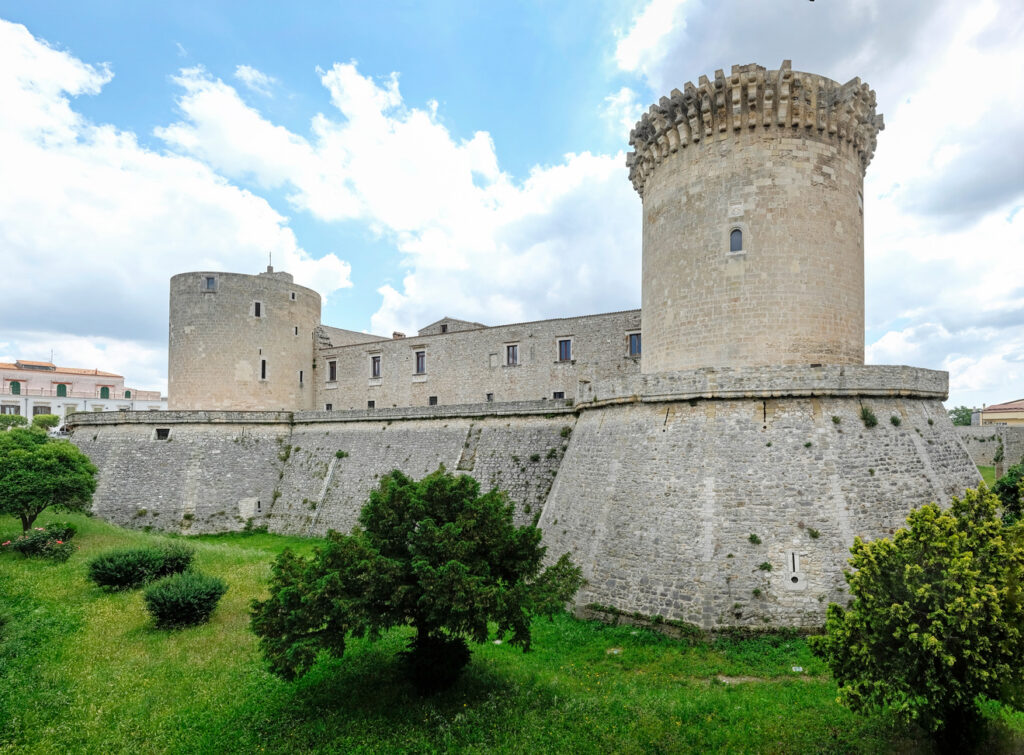
It was Pirro Del Balzo who financed its construction in 1460-70 by choosing the site occupied by the first Venetian Cathedral as the site. Part of the cylindrical towers that mark the corners of the quadrangular plan and the walls were then erected, while the excavation of the moat, the erection of the ramparts and the internal loggia on the pillars date back to the time of the Spanish viceroyalty (1553), XIII century the whole north-west wing.
Many signs left by the Del Balzo family, such as the family crest (a radiant sun) that stands out on the corbel battlements of the west tower (inside is a cistern with a complete rainwater collection system). The two lions at the beginning of the access bridge come from Roman ruins.
It belonged as a fiefdom to various families including that of Carlo Gesualdo, prince of Venosa and great madrigalist, protagonist of a serious act of blood. Four years after the wedding, Don Carlo Gesualdo, in the Neapolitan residence, after having pretended to go hunting and having made believe that he would not return in the evening, surprised his wife Maria D’Avalos and his cousin Fabrizio Carafa, Duke of Andria, lovers , fall asleep, killing them barbarously.
Finally, always with regard to the castle, we must not forget the ancient popular legend according to which, every year on the night of October 24, the feast of San Felice, the procession of souls in purgatory or Christian martyrs would be held in the moat.
The entrance hall leads to the walkway, a basement gallery equipped with slits and sentry boxes. The interior of this is used in part for the National Archaeological Museum, which contains a choice of materials aimed at connoting the historical development of the city and the territory gravitating on it from the prehistoric phase (from the Paleolithic to the Bronze Age, to which it is dedicated exposure in the north bastion) to the late Empire and the Normans. The path dedicated to the historical age is divided into five large sections, all enriched with numerous epigraphs, mostly of a funerary nature. In the first, dedicated to the pre-Roman age, the askos catarinella from Lavello stands out. The sections dedicated to the development of the Latin colony follow, in which there is an Oscan fragment of the Tabula bantina and a head of Diadumeno, a marble work of the 2nd century AD. taken from an original by Polykleitos, returned from the United States where it had merged after being stolen in 1956 by Venosa and transferred there illegally. Interesting are the ceramics, the floor mosaics, the wall paintings and the sepulchral typologies, which are accompanied, by now in the early Christian era, a cross-reliquary of the VIII-IX century, earrings of the V-VI.
From the internal courtyard of the Castle you go up to the loggia opened at the time of the transformation of the fortress into a residence; of which one passes in the municipal library and in the two reception halls, with vaults painted by allegorical subjects in the seventeenth century. To the left of the Castle begins via Fornaci, whose toponym refers to the brick workshops opened in the ravines of the hill and remained active until the beginning of the 20th century. decorated with sepulchral bas-reliefs and a lion; the legend tells of the magical powers of the water that flows here: the foreigner who quenches his thirst with it no longer leaves Venosa.
